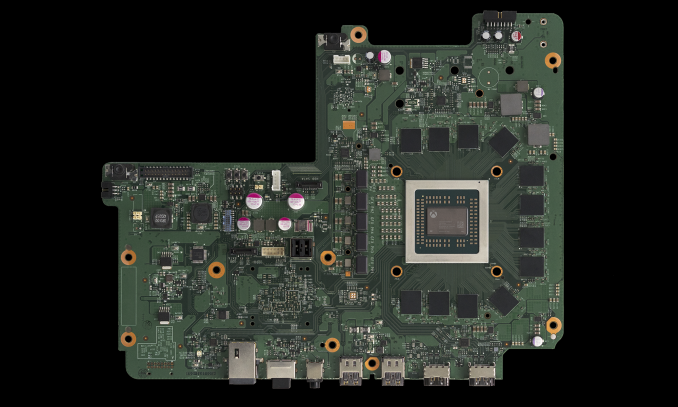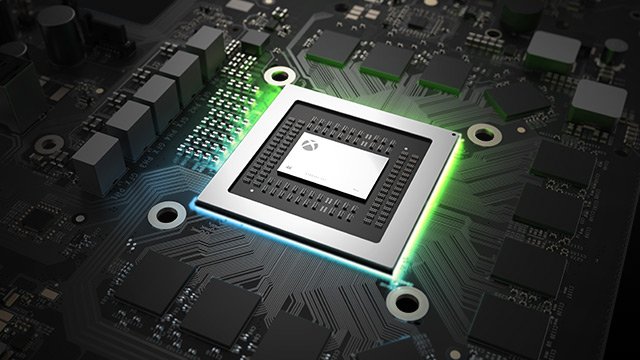The Xbox One X Review: Putting A Spotlight On Gaming
by Brett Howse on November 3, 2017 3:01 AM EST- Posted in
- Consoles
- Microsoft
- Xbox One
- Xbox
- Xbox One X
Powering Xbox One X: The Scorpio Engine
The heart of the Xbox One X is a custom AMD APU, which Microsoft is dubbing the Scorpio Engine. This APU features eight CPU cores and forty GPU compute units, essentially making it a vastly more powerful version of the APU found in the original Xbox One. All of this is built on TSMC’s 16 nm fab process, packing seven billion transistors into 360 mm2. Amazingly, that’s almost exactly the same size die as the original Xbox One, although quite a bit larger than the 240 mm2 of the Xbox One S, which is also built on TSMC 16 nm. Thanks to quite a bit of disclosure from Microsoft between the time the Xbox Project Scorpio was announced, until the launch of the Xbox One X, we know quite a bit about what’s powering the latest console.
 Image Source: Digital Foundry
Image Source: Digital Foundry
Eight Custom CPU Cores
The original Xbox One featured eight CPU cores based on the AMD Jaguar microarchitecture, and the Xbox One X keeps that completely intact. There’s still eight cores, and they are still based on a slightly upgraded version of Jaguar. Microsoft stated the CPU performance increased 31% over the original console, and they achieved that with a frequency bump from 1.75 GHz to 2.3 GHz.
This likely came down to several factors. They may have been able to leverage Ryzen cores, but it would have been difficult to get Ryzen into the new APU on the timelines required. Jaguar is also going to take up less of their die space as well, which is important when you are limited by your total die budget, and as we saw with the Xbox One’s eSRAM, taking die space for non-GPU functions can be a problem. Finally, since the Xbox One X will be completely backwards compatible with the Xbox One, keeping the same CPU architecture likely makes this an easier transition.
Microsoft calls these custom CPU cores, and while we’ll likely never get all of the information on what’s custom on them, Microsoft has released a couple of details. In particular, these new CPU cores implement a page descriptor cache of nested translations, which is a fairly low level optimization to the cache design that allows Microsoft to offset some of the remaining overhead that comes from their use of virtual machines by better caching the VM's memory operations. This optimization gets the Scorpio Engine a few percent more in average CPU performance. But regardless, the custom x86 CPU is 31% faster than the original Xbox One thanks to a 31% higher frequency. Clearly the team’s testing and research showed that this was enough CPU for the expected requirements.
12 GB GDDR5 System Memory
Arguably the biggest change to the Xbox One X is the move from 8 GB of DDR3 with a 32 MB eSRAM buffer, to 12 GB of GDDR5 memory, clocked at 6.8 Gbps. This isn’t just because there’s more RAM, but more because it gets rid of the eSRAM. The Xbox One X has twelve 32-bit channels for the GDDR5, resulting in a 384-bit memory interface. Coupled with the 6.8 Gbps data rate, that provides 326 GB/s of system memory bandwidth. 9 GB of RAM is available to developers, with 3 GB reserved for the system to handle multi-tasking. The original plan for a 4K dashboard got dropped to provide more RAM to developers, so the 3 GB matches the same reservation as the original Xbox One console.
The original Xbox One had just 68.3 GB/s of system memory bandwidth, and compensated with a 102 GB/s bi-directional eSRAM buffer. The Xbox One X no longer requires that buffer, thanks to copious amounts of bandwidth for main memory, which frees up a lot of die space on the APU. I wonder what they’ll use that space for?
40 GPU Compute Units at 1172 MHz
Microsoft was able to invest almost all of the free die space from the removal of the eSRAM into improving the GPU. The Xbox One X ships with the most powerful GPU in any console, and features an AMD custom GPU.
The heart of the Xbox One X is a GPU that's roughly based on AMD’s GCN 4 (Polaris) architecture. It offers 40 compute units, 2560 stream processors, and 32 ROPs. For comparison, an AMD Radeon RX 480 offers 36 CUs, so the Xbox One X offers 11% more compute hardware than the RX 480. Compared to the PlayStation 4 Pro, the Xbox One X offers about 43% more shader throughput.
There’s of course more custom blocks here as well. A console designed for 4K and HDR still needs to work with SDR 1080p displays, and the Xbox display controller can supersample down from 4K to 1080p, or even 1440p, as needed. There’s media blocks for HEVC as well, to handle the 4K video requirements for Blu-Ray and streaming, and the Xbox Game Capture can also capture at 4K now.
Storage: SATA HDD
For those hoping for all flash based storage in their console, those days are still a long way off. The amount of storage needed for games, especially those with 4K assets, is copious, to say the least, so for now we’re stuck with spinning disks. Digital Foundry reports that the Xbox One X will have 50% more bandwidth to the hard drive, which likely means the latest model is finally SATA III, rather than SATA II, for the 2.5” HDD. Unlike the short lived Xbox One Elite, there doesn’t appear to be any SSHD options at this time.
If you need extra storage, the Xbox One supports external USB storage. It would be nice if Microsoft had made it possible to replace the internal storage easily, but so far, they don’t seem to want to do that. Adding external storage is pretty simple though.
UHD Blu-Ray
Like the Xbox One S, the Xbox One X ships with a UHD Blu-Ray drive, allowing you to play UHD/4K movies with HDR support. There’s no support for Dolby Vision currently.
Hardware Summary
There’s a lot of performance packed into the new Xbox One X. Microsoft was too conservative with the original Xbox One, and they seem to be out to prove that they won’t make that mistake again. This is a console designed to target 4K right from the start. As to how successful they will be, that will depend on the developers, and the ever-evolving trade-off between more complex scenes, and higher resolution, but with a GPU that is almost five times more powerful than the original Xbox One, coupled with 12 GB of 384-bit GDDR5, and a faster CPU, the aim looks like its on target.













128 Comments
View All Comments
Hixbot - Monday, November 6, 2017 - link
The gaming scenarios that are currently locked at 30fps are CPU bound, they cannot reach 60fps because of the CPU.Samus - Friday, November 3, 2017 - link
CPU and core count are unimportant for DirectX 12 games. Microsoft would have likely been happy to go with 4 cores to give them even more GPU real estate in Xbox One X, but they had to keep it backwards compatible and that would have been severely ruined by doing so.I don't understand why the original PS4/Xbox One were 8-core CPU's...it's been pretty obvious for at least a decade that GPU's are more critical to graphics, and since both consoles were effectively built during the DX12-era which was pushing even further away from CPU limitations...it seems Microsoft in particular went 8-core just to appear "on paper" competitive with the PS4. Yet another mistake to add to the list of f-up's on the Xbox One.
I passed this whole generation. The PS3/Xbox 360 were really the last revolutionary consoles. I spent this generation focusing on PC gaming, and I don't regret it.
Hixbot - Monday, November 6, 2017 - link
There is most certainly a CPU bottleneck if 60fps is the target.Rufnek - Monday, November 6, 2017 - link
@SamusYou are spitting non-sense. Your comments would ring true for pretty much everything up to 2015. Thankfully Sony & M$ were looking further out than your experiences. CPU need to have a lot of cores running at high speeds. At best, they need to tackle all the other parts that the GPU doesn't. At worst, the CPU needs to overlap and assist the GPU. AC: Origins is one of the prime examples.
As for CPU cores...there is a reason Intel is now trying to catch up to AMD on the # of cores. Expect a lot of software companies to following gaming devs in cpu core utilizations. More cores = better.
tipoo - Friday, November 3, 2017 - link
Imagine if people got GPU mining going on consoles, we'd never get those either lolSamus - Friday, November 3, 2017 - link
Shhhhhh. ;)dguy6789 - Sunday, November 5, 2017 - link
Well, considering that a regular Xbox One or PS4 runs games significantly better than a $500 PC, I would imagine the X would compare extremely favorably.xenol - Monday, November 6, 2017 - link
Every time I see a comparison being made, a few things get left behind that make me think the comparison is not fair. For instance, I see people omitting the BD drive, which I find makes the comparison pointless. Gaming consoles aren't just for gaming, at least on the Sony and Microsoft camp. They're trying to be a complete entertainment system. So you can't just pick and choose which features you want and keep the same budget for comparison's sake.Silma - Tuesday, November 7, 2017 - link
During the conference call for the last quarter, Microsoft warned investors that the Xbox One X would weigh on its financial results next quarter.So basically Microsoft doesn't make a dime on it. I doubt you'll find a better deal on a PC.
jai_86 - Monday, December 24, 2018 - link
If you want to play Halo, Gears of War, Forza or Crackdown, pretty well.